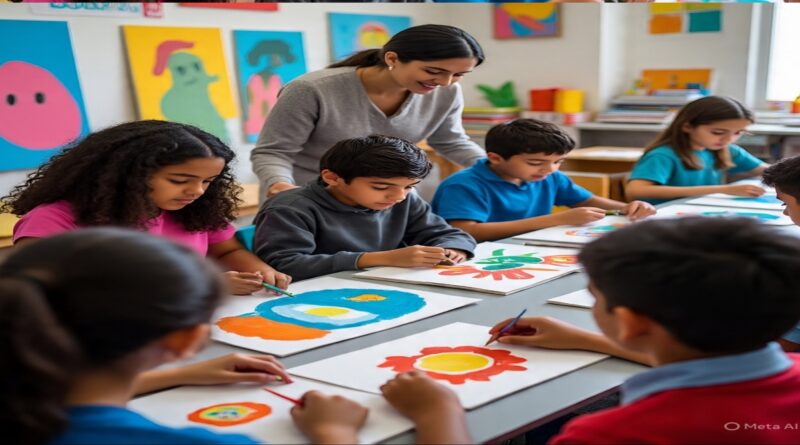Why Art Education Matters in Schools
Art education matters in schools because it nurtures creativity, emotional expression, and problem-solving skills that traditional academic subjects often overlook. When students engage with drawing, painting, music, or theater, they develop imagination, confidence, and innovative thinking all essential for success in the modern world. Why art education matters in schools goes far beyond learning to draw; it’s about shaping well-rounded, thoughtful individuals who can express themselves and think critically.
The Role of Art in a Child’s Development.
From an early age, art helps children express thoughts and feelings they may not yet have words for. It allows them to explore shapes, colors, and ideas in a safe and imaginative way. Through art, children learn patience, focus, and observation skills that support their growth in all areas of learning.
Moreover, creating art gives children a sense of accomplishment. When a child ucompletes a painting or performs a short play, they feel proud and recognized for their efforts. This builds self-esteem and motivates them to take on new challenges both inside and outside the classroom.
Art Boosts Creativity and Innovation.
In a world that constantly demands innovation, creativity has become one of the most valuable skills. Art education encourages students to think outside the box and find new ways to solve problems. Whether they are sketching a design or composing a song, they are learning how to create something unique something that didn’t exist before.
Many of the world’s greatest inventors, designers, and entrepreneurs credit their artistic experiences as the source of their creativity. Through art, students learn that there is no single “right answer,” which helps them approach real-world problems with flexible, open-minded thinking.
IConnecting Art and Academic Performanc
Research shows a strong link between art education and improved academic performance. Students who study art tend to perform better in reading, math, and science. This is because art helps the brain develop in areas related to memory, focus, and critical thinking.
When students analyze a painting, they practice observation and interpretation. When they perform music, they strengthen their memory and discipline. These cognitive benefits translate into improved performance in traditional subjects as well.
Art Teaches Emotional Intelligence and Empathy.
Art education is not just about individual creativity; it also encourages teamwork. Group projects, theater plays, and music performances require communication, cooperation, and respect for others’ ideas. Students learn how to give and receive feedback, listen actively, and work toward a shared goal skills that are essential in every profession.
This collaborative environment prepares students for the workplace, where teamwork and creativity are key to success.
Cultural Awareness Through Art.
Art is deeply connected to culture and history. When students learn about art from different regions and time periods, they gain insight into the traditions, beliefs, and values of various societies. This fosters global awareness and appreciation for diversity.
For instance, studying African masks, Islamic calligraphy, or Renaissance paintings helps students understand how art reflects identity and community. Such exposure makes students more culturally literate and respectful citizens of the world.
Art Builds Confidence and Self-Expression.
Confidence is one of the greatest gifts of art education. Every drawing, sculpture, or performance gives students a voice a way to express who they are. Over time, this builds self-assurance and courage to share their ideas.
Art encourages students to take risks and accept mistakes as part of the creative process. They learn that perfection isn’t the goal expression is. This mindset helps them approach life’s challenges with resilience and confidence.
Preparing Students for the Future.
In today’s rapidly changing world, creativity, innovation, and emotional intelligence are as important as technical skills. Employers increasingly look for individuals who can think creatively, adapt quickly, and communicate effectively. Art education develops precisely these qualities.
Whether students choose careers in science, business, or technology, the creative and emotional skills they gain from art will give them a competitive edge. That’s why integrating art into the school curriculum isn’t optional it’s essential for preparing future leaders.
Preparing Students for the Future
In today’s rapidly changing world, creativity, innovation, and emotional intelligence are as important as technical skills. Employers increasingly look for individuals who can think creatively, adapt quickly, and communicate effectively. Art education develops precisely these qualities.
Whether students choose careers in science, business, or technology, the creative and emotional skills they gain from art will give them a competitive edge. That’s why integrating art into the school curriculum isn’t optional it’s essential for preparing future leaders.
How Schools Can Promote Art Education
To make art education more effective, schools should:
Include dedicated art, music, and theater classes in the curriculum.
Provide access to art supplies, instruments, and creative spaces.
Encourage cross-disciplinary projects that combine art with science or literature.
Support art exhibitions and performances to celebrate students’ work.
Partner with local artists and communities to inspire creativity.
Such initiatives not only improve learning outcomes but also make schools more joyful and inspiring places.
Conclusion: Art Education Creates Balanced, Creative Thinkers
Art education is not just an extracurricular activity it’s a foundation for emotional, intellectual, and social development. It teaches students how to think creatively, express themselves confidently, and understand the world around them.
That’s why art education matters in schools it builds not only future artists but also innovators, leaders, and compassionate human beings. Investing in art is investing in the next generation’s ability to imagine, create, and make the world a better place.



